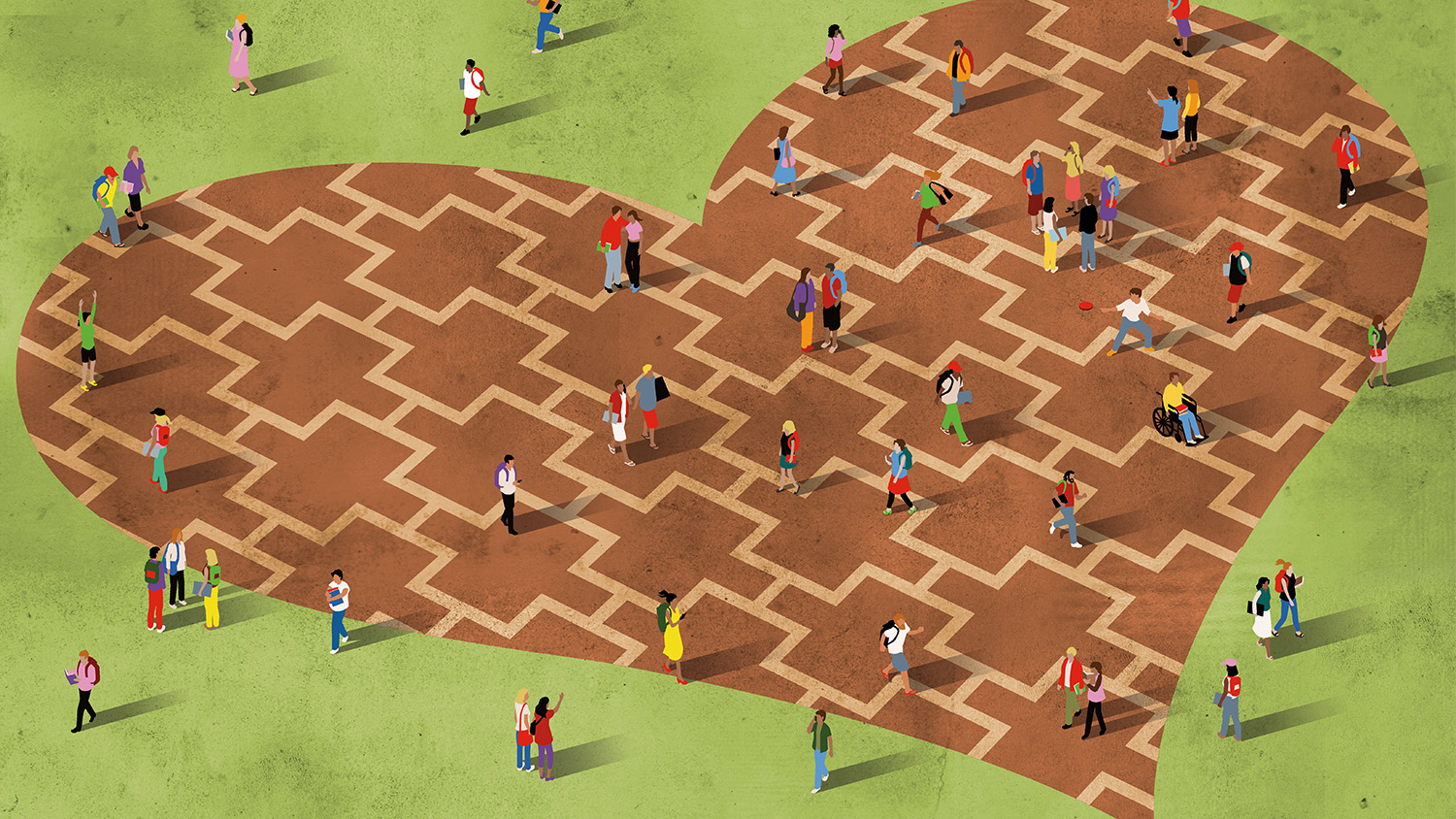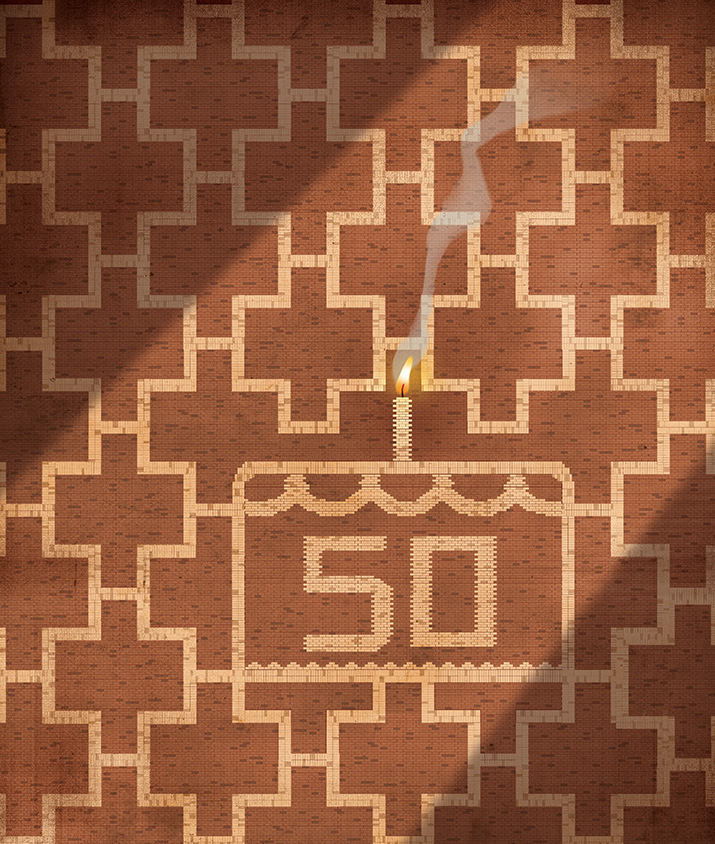You Were Here.
With the Brickyard getting a facelift of sorts, we revisit NC State magazine’s 2018 feature celebrating the spot’s 50th birthday.

The plans were announced in a Technician article in February 1965, headlined, “Campus Landscaping Soon to be Undertaken.”
“Students who are sick of the muddy cowpaths between Erdahl-Cloyd Union and Harrelson — Rejoice!” The story went on to say that the plan to landscape the area included “extensive paving” so that students could get to class easily without destroying grass.
“Extensive paving” may have been an understatement. This would be more than a system of sidewalks — and in the end a swath of land was paved over with red and white brick in a distinctive pattern to create what later came to be known as the Brickyard.

The Brickyard is 50 years old, and today it’s almost as iconic a symbol of NC State as the Bell Tower. In fact, that’s what its designer, Richard C. Bell ’50, had in mind. “Carolina has its well, its great symbol,’’ he told Chancellor John Caldwell after he was hired for the project. “Ours will be a symbol of urban design.’’ In an oral history archived at D.H. Hill Library, Bell remembers Caldwell’s response: “That’s a good idea. Go ahead.”
“Ours will be a symbol of urban design.”
– Richard C. Bell ’50
The Brickyard came of age in turbulent times. Only a few weeks after the dedication in March 1968, Martin Luther King Jr. was assassinated, and the Brickyard was the site of its first protest gathering. Many more were to follow, as students rallied against the Vietnam War and shootings at Kent State. It also became the site of celebration, most notably during the Wolfpack basketball team’s run to the national championship in 1983. And it was a place for sorrow. Immediately after the terrorist attacks of Sept. 11, 2001, students, faculty and staff came together on the Brickyard, locking arms and shedding tears.
By the Numbers
500 Approximate number of bricks students steal from the Brickyard each year.
225,000 Total number of red and white bricks
15,000 Official capacity number of people who can fit in the Brickyard
Today, the Brickyard is one of nine “hallowed places” on campus — a list that also includes Reynolds Coliseum, Holladay Hall and the Free Expression Tunnel. The designation is given only to places or buildings that have “accrued special meaning” over time. (In October 2023, the Oval on Centennial Campus was designated as NC State’s 10th “hallowed place.”) Read on for some little-known facts about the bricks that ended up doing a lot more than just keeping the mud off our shoes.
In the Middle of Campus
Bell was retained in 1965 by Caldwell, who had pulled together funding for some campus landscaping projects. The idea was that Bell would use the money at 10 different sites. “I said to the chancellor, ‘This is foolish,’’’ Bell remembered in the oral history. Instead, he recommended the money be consolidated into one major project that would have a lasting impact. “Put it right in the middle of campus,” Bell told Caldwell.
Signs of the Times
- March 7, 1968
The Brickyard is dedicated.
- April 6, 1968
After the assassination of Martin Luther King Jr., students and faculty gather in the Brickyard planning to march on the capitol, but the group is stopped at Winston Hall by police.
- May 1970
The Brickyard is the site of protests in the aftermath of U.S. expansion of the Vietnam War into Cambodia and the Kent State shooting. Thousands march down Hillsborough Street to the capitol.
- March/April 1983
The Brickyard is home to victory celebrations as NC State’s basketball team wins the ACC championship and then the NCAA tournament.
- 1987
The “Listening Vessels” are placed in the Brickyard.
- January 1991
Students hold a rally to oppose military action in Operation Desert Storm, and a candlelight ceremony is held to honor the troops.
- February 1992
NC State’s chapter of Habitat for Humanity holds its Shack-a-thon, with students living in shacks on the Brickyard to raise money.
- 2006
The Block S on the Brickyard is changed to include the “N” and “C” after Chancellor James Oblinger said it “looks like this is Stanford.”
- Oct. 20, 2011
A rally is held to support the GLBT community following vandalism of the GLBT Center, now known as the LGBTQ Pride Center.
- Feb. 12, 2015
A candlelight vigil honors the lives of two alumni and a student who were murdered at their Chapel Hill, N.C., home.
- Aug. 21, 2017
Students, faculty, staff and Raleigh residents gather on the Brickyard to watch the solar eclipse.
Trees and Bushes
Bell noted that at the time landscaping was considered little more than planting bushes, and he wanted a different approach. In fact, he had originally hoped to add art and sculpture to the plaza, but many students complained about the lack of trees. A group of landscape design students, calling themselves the Green Panthers, launched a campaign in 1970 to buy and plant trees on the Brickyard. Eventually an alumnus who owned a nursery, Gordon Butler ’57, donated the trees, all about 30 feet high — three willow oaks, two scarlet oaks and two red maples.
Donated Bricks
The budget for the project was only $150,000. Just two bids were received, each running $300,000. So Bell put out the word to North Carolina brick companies, asking them to donate red bricks for the project, and they agreed. “We had to buy the white bricks from South Carolina,” Bell said, “because none of our brick companies made white bricks.”
Naming Rights
The official name of the Brickyard is University Plaza. A Technician story about the dedication called it “the brick mall project,” and it wasn’t long before students began calling it the name we know it by today. A January 1969 Technician article referred to it as “the Brickyard, alias University Plaza,” and noted that a survey had shown that less than 40 percent of students were calling it by its proper name.
European Inspiration
Bell, who was from Manteo, N.C., won the Prix de Rome in 1951, allowing him to study architecture in Europe for two years, where he was enthralled by some of the public plazas. It’s been long held that the Piazza San Marco in Venice, Italy, provided the inspiration for the Brickyard. But in the oral history, Bell didn’t mention the Venice location. He instead talked about the Major Plaza in Madrid. Both feature paved courtyards.
- Categories:


